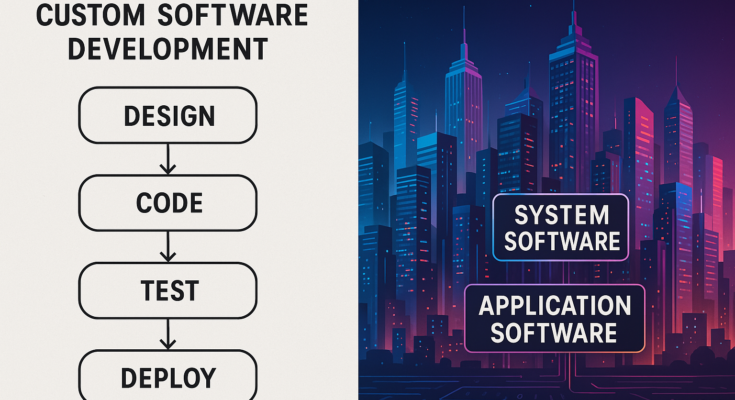Software 101: The Backbone of Digital Life
1. System Software – The Foundation
- Operating Systems: The unsung heroes like Windows, macOS, and Linux that manage hardware and let apps thrive.
- Drivers: Translators helping your OS chat with printers, graphics cards, and other gadgets.
- Utilities: Digital janitors like antivirus programs and disk cleaners that keep your system humming.
2. Application Software – The Everyday Tools
- Productivity Suites: Microsoft Word drafts your resume; Excel crunches numbers.
- Creativity Powerhouses: Photoshop edits photos; Blender crafts 3D worlds.
- Browsers: Chrome and Firefox gateways to the internet’s infinite library.
3. Custom Software – The Tailored Solution
Built for a single client—whether a hotel’s booking system or a factory’s inventory tracker—it’s software that fits like a glove.
Why Go Custom? The Pros and Pitfalls
Pros
- Precision Fit: Solves your problem, not a generic one.
- Scalability: Grows alongside your business.
- Full Control: Own the features, security, and updates.
Cons
- Cost: Developing from scratch is pricier than buying off-the-shelf.
- Time: Building a masterpiece takes weeks (or months).
- Dependency: You’re tied to the developers for maintenance.
Building Bespoke: The Custom Software Lifecycle
1. Blueprint Phase (Requirements Gathering)
Developers interview stakeholders, dissecting needs like detectives. “Should the hotel app sync with Google Calendar? Can the inventory tool predict stock shortages?”
2. Architecting the Vision (Design & Planning)
UI/UX designers sketch user interfaces while engineers map databases and APIs. Think of it as drafting a skyscraper’s blueprint.
3. Construction Zone (Development)
Coders wield languages like Python, JavaScript, or C#, assembling features module by module. Agile methodology keeps teams nimble, with weekly sprints and check-ins.
4. Stress Testing (QA)
Testers hunt bugs—from typos to security gaps. Automated tools like Selenium run thousands of simulations, while ethical hackers probe for weaknesses.
5. Grand Opening (Deployment)
The software launches, either all at once (“Big Bang”) or in phases. Cloud platforms like AWS or Azure host it globally.
6. Forever Upkeep (Maintenance)
Post-launch, developers patch issues, add features, and tighten security—like renovating a building to withstand storms.
Tools of the Trade: Languages and Technologies
🌐 Frontend (The User’s Playground)
- Languages: HTML, CSS, JavaScript
- Frameworks: React.js (Meta), Vue.js (Netflix), Angular (Google)
🔧 Backend (The Engine Room)
- JavaScript: Node.js for real-time apps
- Python: Django for data-heavy platforms
- Java: Spring Boot for enterprise giants
📱 Mobile Development
- Android: Kotlin
- iOS: Swift
- Cross-Platform: Flutter (Google) or React Native (Meta)
🗄️ Databases
- SQL: MySQL, PostgreSQL (structured data)
- NoSQL: MongoDB (flexible, scalable)
☁️ Cloud & DevOps
- Hosting: AWS, Google Cloud, Azure
- Containers: Docker for app portability
- Version Control: Git/GitHub for tracking code changes
When to Choose Custom Software
- Unique Workflows: Your business operates differently (e.g., a farm-to-table logistics app).
- Competitive Edge: Off-the-shelf tools can’t match your innovation.
- Data Control: Keep sensitive info under lock and key, away from generic platforms.


